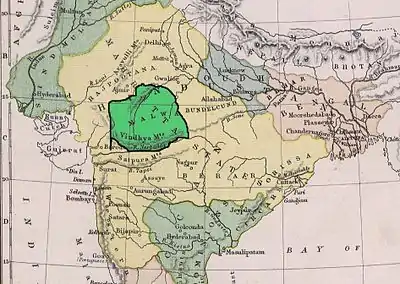List of rulers of Malwa
Sri Doshra Bhil Dynasty ( 1400 Bce - 1113 Bce)
Bhil queen Doshra was allegedly the ruler of Malwa state comprising a large portion of the present - day western and central Madhya Pradesh , and parts of southeastern Rajasthan and northern Maharashtra ,whose ansestors had ruled malwa for 289 years.[1]
Malava dynasty (c. 1113 – 840 BCE)
Dhanna Bhil dynasty (c. 840 – 400 BCE)
BhilKing Dhanna and his descendants dynasty ruled Malwa before feudatories to Malavas until 400s BCE.
. The descendants of Raja Dhanna Bhil challenged the ruler of Delhi in 730 BC. The last ruler of the Bhil dynasty was Putraaj.[5][6]
Malwa under Magadha dynasties

Haryanka dynasty (c. 544 – 413 BCE)
- Rulers-
| Ruler | Reign (BCE) |
|---|---|
| Bimbisara | 544–491 BCE |
| Ajatashatru | 491–461 BCE |
| Udayin | 461–428 BCE |
| Anirudha | 428–419 BCE |
| Munda | 419–417 BCE |
| Darshaka | 417–415 BCE |
| Nāgadāsaka | 415–413 BCE |
Shishunaga dynasty (c. 413 – 345 BCE)
- Rulers-
| Ruler | Reign (BCE) |
|---|---|
| Shishunaga | 413–395 BCE |
| Kalashoka | 395–377 BCE |
| Kshemadharman | 377–365 BCE |
| Kshatraujas | 365–355 BCE |
| Nandivardhana | 355–349 BCE |
| Mahanandin | 349–345 BCE |
Nanda Empire (c. 345 – 322 BCE)
- Rulers-
| Ruler | Reign (BCE) |
|---|---|
| Mahapadma Nanda | 345–340 BCE |
| Pandhukananda | 340–339 BCE |
| Panghupatinanda | 339–338 BCE |
| Bhutapalananda | 338–337 BCE |
| Rashtrapalananada | 337–336 BCE |
| Govishanakananda | 336–335 BCE |
| Dashasidkhakananda | 335–334 BCE |
| Kaivartananda | 334–333 BCE |
| Karvinathanand | 333–330 BCE |
| Dhana Nanda | 330–322 BCE |
Maurya Empire (c. 322 – 185 BCE)
- Rulers-
| Ruler | Reign | Notes | |
|---|---|---|---|
| Chandragupta Maurya |  | 322–297 BCE | Founder of first Indian united empire. |
| Bindusara | 297–273 BCE | Known for his foreign diplomacy and crushed of Vidarbh revolt. | |
| Ashoka |  | 268–232 BCE | Greatest emperor of dynasty. His son Kunala was blinded and died before his father. Ashoka was succeeded by his grandson. Also known for Kalinga war victory. |
| Dasharatha Maurya |  | 232–224 BCE | Grandson of Ashoka. |
| Samprati | 224–215 BCE | Brother of Dasharatha. | |
| Shalishuka | 215–202 BCE | ||
| Devavarman | 202–195 BCE | ||
| Shatadhanvan | 195–187 BCE | The Mauryan Empire had shrunk by the time of his reign | |
| Brihadratha | 187–184 BCE | Assassinated by his Commander-in-chief Pushyamitra Shunga in 185 BCE. | |
Shunga Empire (c. 185 – 73 BCE)
- Rulers-
| Ruler | Reign (BCE) |
|---|---|
| Pushyamitra Shunga | 185–149 BCE |
| Agnimitra | 149–141 BCE |
| Vasujyeshtha | 141–131 BCE |
| Vasumitra | 131–124 BCE |
| Bhadraka | 124–122 BCE |
| Pulindaka | 122–119 BCE |
| Ghosha | 119–108 BCE |
| Vajramitra | 108–94 BCE |
| Bhagabhadra | 94–83 BCE |
| Devabhuti | 83–73 BCE |
Malwa under Andhra-Satavahana Empire (c. 100 BCE – 200 CE)
Himanshu Prabha Ray provides the following chronology, based on archaeological and numismatic evidence:[7]
- Simuka (before 100 BCE)
- Kanha (100–70 BCE)
- Satakarni I (70–60 BCE)
- Satakarni II (50–25 BCE)
- Kshatrapa interregnum with vassal Satavahana kings like Hāla
- Nahapana (54-100 CE)
- Gautamiputra Satakarni (86–110 CE)
- Pulumavi (110–138 CE)
- Vashishtiputra Satakarni (138–145 CE)
- Shiva Shri Pulumavi (145–152 CE)
- Shiva Skanda Satakarni (145–152 CE)
- Yajna Shri Satakarni (152–181 CE)
- Vijaya Satakarni (until 200s CE)
Malwa under Kushan Empire (c. 1 – 375 CE)
| Ruler | Reign | Notes | |
|---|---|---|---|
| Heraios | 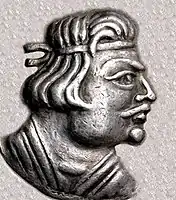 | 1–30 | King or clan chief of the Kushans. Founder of the dynasty. |
| Kujula Kadphises | 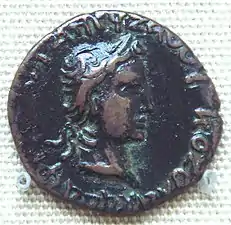 | 30–80 | United the Yuezhi confederation during the 1st century, and became the first Kushan emperor. |
| Vima Takto Soter Megas | 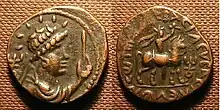 | 80–90 | Alias The Great Saviour. His empire covered northwestern Gandhara and greater Bactria towards China, where Kushan presence has been asserted in the Tarim Basin. Under his reign, embassies were also sent to the Chinese court. |
| Vima Kadphises | 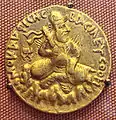 | 90–127 | The first great Kushan emperor. He introduced gold coinage, in addition to the existing copper and silver coinage. Most of the gold seems to have been obtained through trade with the Roman Empire. |
| Kanishka I the Great | 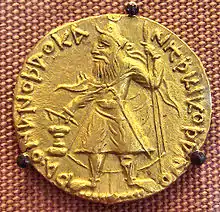 | 127–144 | Came to rule an empire in Bactria extending to Pataliputra on the Gangetic plain. His conquests and patronage of Buddhism played an important role in the development of the Silk Road, and in the transmission of Mahayana Buddhism from Gandhara across the Karakoram range to China. |
| Huvishka |  | 144–191 | His rule was a period of retrenchment and consolidation for the Empire. |
| Vasudeva I | 191–232 | He was the last great Kushan emperor, and the end of his rule coincides with the invasion of the Sassanians as far as northwestern India, and the establishment of the Indo-Sassanians or Kushanshahs from around 240. | |
| Kanishka II | 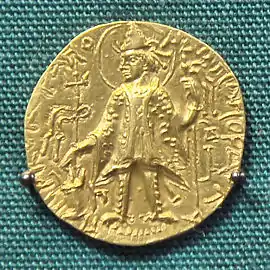 | 232–245 | It is likely he lost part of his empire to the Kushano-Sassanians. |
| Vashishka |  | 245–250 | |
| Kanishka III | .jpg.webp) | 250–275 | |
| Vasudeva II |  | 275–310 | |
| Chhu | 310–325 | ||
| Vasudeva III | c.300? | Kings whose existence is uncertain. | |
| Vasudeva IV | |||
| Vasudeva V | |||
| Shaka Kushan/Shaka I | 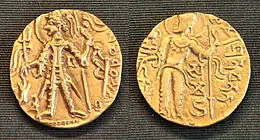 | 325–350 | |
| Kipunada |  | 350–375 | May have been a subject of Samudragupta from Gupta Empire. |
Western Saka dynasty (c. 119 – 395 CE)
- Nahapana (119–124)
- Chastana (124)
- Jayadaman (124–130)
- Rudradaman I (130–170)
- Damajadasri I (170–175)
- Jivadaman (175–199)
- Rudrasimha I (175–188)
Abhira interregnum-
- Isvaradatta (188–191)
Restored Satraps-
- Rudrasimha I (restored) (191–197)
- Jivadaman (197–199)
- Rudrasena I (200–222)
- Samghadaman (222–223)
- Damasena (223–232)
- Damajadasri II (232–239)
- Viradaman (234–238)
- Yasodaman I (239)
- Vijayasena (239–250)
- Damajadasri III (251–255)
- Rudrasena II (255–277)
- Visvasimha (277–282)
- Bhratadarman (282–295)
- Visvasena (293–304)
- Rudrasimha II (304–317)
- Yasodaman II (317–332)
- Rudradaman II (332–348)
- Rudrasena III (348–380)
- Simhasena (380–382)
- Rudrasena IV (382–388)
- Rudrasimha III (388–395)
Bharshiva dynasty (Nagas of Padmavati) (c. 175 – 325 CE)
- Vrisha-naga
(Possibly ruled at Vidisha in the late 2nd Century).
- Vrishabha or Vrisha-bhava
(May also be the name of a distinct king who succeeded Vrisha-naga).
- Bhima-naga (210–230 CE)
(Probably the first king to rule from Padmavati)
- Skanda-naga
- Vasu-naga
- Brihaspati-naga
- Vibhu-naga
- Ravi-naga
- Bhava-naga
- Prabhakara-naga
- Deva-naga
- Vyaghra-naga
- Ganapati-naga
Malwa under Gupta Empire (c. 335 – 550 CE)
- List of complete Gupt rulers-
| Ruler | Reign | Notes | |
|---|---|---|---|
| Sri-Gupta I | 240–290 | Founder of the dynasty. | |
| Ghatotkacha | 290–319 | ||
| Chandra-Gupta I |  | 319–335 | His title Maharajadhiraja ("king of great kings") suggests that he was the first emperor of the dynasty. It is not certain how he turned his small ancestral kingdom into an empire, although a widely accepted theory among modern historians is that his marriage to the Licchavi princess Kumaradevi helped him extend his political power. |
| Samudra-Gupta |  | 335–375 | Defeated several kings of northern India, and annexed their territories to his empire. He also marched along the south-eastern coast of India, advancing as far as the Pallava kingdom. In addition, he subjugated several frontier kingdoms and tribal oligarchies. His empire extended from Ravi River in the west to the Brahmaputra River in the east, and from the Himalayan foothills in the north to central India in the south-west; several rulers along the south-eastern coast were his tributaries. |
| Kacha | 4th-century | Rival brother/king, possibly an usurper, there are coins who attest him as ruler; possibly identical with Samudra-Gupta. | |
| Rama-Gupta | 375–380 | ||
| Chandra-Gupta II Vikramaditya |  | 380–415 | Continued the expansionist policy of his father Samudragupta: historical evidence suggests that he defeated the Western Kshatrapas, and extended the Gupta empire from the Indus River in the west to the Bengal region in the east, and from the Himalayan foothills in the north to the Narmada River in the south. |
| Kumara-Gupta I |  | 415–455 | He seems to have maintained control of his inherited territory, which extended from Gujarat in the west to Bengal region in the east. |
| Skanda-Gupta |  | 455–467 | It is stated that he restored the fallen fortunes of the Gupta family, which has led to suggestions that during his predecessor's last years, the Empire may have suffered reverses, possibly against the Pushyamitras or the Hunas. He is generally considered the last of the great Gupta Emperors. |
| Puru-Gupta | 467–472 | ||
| Kumara-Gupta II Kramaditya |  | 472–479 | |
| Buddha-Gupta |  | 479–496 | He had close ties with the rulers of Kannauj and together they sought to run the Alchon Huns (Hunas) out of the fertile plains of Northern India. |
| Narasimha-Gupta Baladitya |  | 496–530 | |
| Kumara-Gupta III | 530–540 | ||
| Vishnu-Gupta Candraditya |  | 540–550 | |
| Bhanu-Gupta | ? | A lesser-known king with uncertain position in the list. | |
Aulikara Empire of Dashapura (c. 300 – 560 CE)
Rulers of First Aulikara dynasty-
- Jayavarma
- Simhavarma
- Naravarma
- Vishvavarma
- Bandhuvarma
Rulers of Second Aulikara dynasty-
- Drumavardhana
- Jayavardhana
- Ajitavardhana
- Vibhishanavardhana
- Rajyavardhana
- Prakashadharma
- Yashodharman (c. 515–545 CE)
Harsha Empire (c. 606–647 CE)
- Harshavardhana (606–647), unified Northern India and ruled it for over 40 years, he was the last non-Muslim emperor to rule a unified Northern India.
Pratihara Empire (c. 725 – 1036 CE)
- Nagabhata I (725–756), last ruler
- Kakustha (756–765)
- Devaraja (765–778)
- Vatsaraja (778–805)
- Nagabhata II (800–833)
- Ramabhadra (833–836)
- Mihira Bhoja (836–890), greatest ruler
- Mahendrapala I (890–910)
- Bhoja II (910–913)
- Mahipala I (913–944)
- Mahendrapala II (944–948)
- Devpala (948–954)
- Vinaykpala (954–955)
- Mahipala II (955–956)
- Vijaypala II (956–960)
- Rajapala (960–1018)
- Trilochanpala (1018–1027)
- Jasapala (Yashpala) (1024–1036), last ruler
Paramara dynasty of Malwa (c. 800 – 1305 CE)
According to historical Kailash Chand Jain, "Knowledge of the early Paramara rulers from Upendra to Vairisimha is scanty; there are no records, and they are known only from later sources."[8]
The Paramara rulers mentioned in the various inscriptions and literary sources include:
- Paramara (early ruler)
- Upendra Krishnraja (late 8 to early 9th century CE)
- Vairisimha (I) (early 9th century CE)
- Siyaka (I) (mid of 9th century CE)
- Vakpati (I) (late 9th or early 10th century CE)
- Vairisimha (II) (middle 10th century CE)
- Siyaka (II) (940–972 CE)
- Vakpati (II) alias Munja (972–990 CE)
- Sindhuraja (990–1010 CE)
- Bhoja (1010–1055 CE), greatest ruler of dynasty
- Jayasimha I (1055–1070 CE)
- Udayaditya (1070–1086 CE)
- Lakshmadeva (1086–1094 CE)
- Naravarman (1094–1130 CE)
- Yashovarman (1133–1142 CE)
- Jayavarman I (1142–1143 CE)
- Interregnum from (1143 to 1175 CE) under an usurper named 'Ballala' and later the Solanki king Kumarapala
- Vindhyavarman (1175–1194 CE)
- Subhatavarman (1194–1209 CE)
- Arjunavarman I (1210–1215 CE)
- Devapala (1218–1239 CE)
- Jaitugideva (1239–1255 CE)
- Jayavarman II (1255–1274 CE)
- Arjunavarman II (1274–1285 CE)
- Bhoja II (1285–1303 CE)
- Mahalakadeva (1303–1305 CE), (after his death dynasty was ended in Malwa region)
Malwa Sultanate rule
Ghorids
- Dilawar Khan (1390–1405)
- Alp Khan Hushang (1405–1435)
- Mahmud Khalji (1435–1436)
Khiljis
- Mahmud Shah I (1436–1469)
- Ghiyath Shah (1469–1500)
- Nasr Shah (1500–1511)
- Muhamud Shah II (1511–1531)
Qadirid
- Qadir Shah (1535–1542)
Shuja'at Khani
- Miyan Bayezid Baz Bahadur (1555–1562)
Mughal rule
- Mughals ruled Malwa from (1562–1720 CE)
Malwa under Maratha Empire (c. 1713 – 1948 CE)

Territory under Maratha control in 1760 (yellow)
Peshwas region (c. 1713 – 1858 CE)
Technically they were not monarchs, but hereditary prime ministers, though in fact they ruled instead of the Chhatrapati (Maratha emperor) after death of Chattrapati Shahu, and were hegemon of the Maratha confederation.
- Balaji Vishwanath (1713–2 April 1720) (b. 1660, died 2 April 1720)
- Peshwa Bajirao I (17 April 1720 – 28 April 1740) (b. 18 August 1700, died 28 April 1740)
- Balaji Bajirao (4 July 1740 – 23 June 1761) (b. 8 December 1721, d. 23 June 1761)
- Madhavrao Ballal (1761–18 November 1772) (b. 16 February 1745, d. 18 November 1772)
- Narayanrao Bajirao (13 Dec 1772–30 August 1773) (b. 10 August 1755, d. 30 August 1773)
- Raghunath Rao Bajirao (5 Dec 1773–1774) (b. 18 August 1734, d. 11 December 1783)
- Sawai Madhavrao (1774–27 October 1795) (b. 18 April 1774, d. 27 October 1795)
- Baji Rao II (6 Dec 1796–3 June 1818) (d. 28 January 1851)
- Nana Sahib (1 July 1857 – 1858) (b. 19 May 1825, d. 24 September 1859)
Dhar State (c. 1730 – 1947 CE)
| Reign start | Reign end | Name | Birth-death |
|---|---|---|---|
| 1728 | 1732 | Udaji Raje I Pawar | |
| 1732 | 1736 | Anand Raje I Pawar | (b. ... – died 1749) |
| 1736 | 1761, 6 January | Yeshwant Raje I Pawar | (1724–1761) |
| 1761, 6 January | 1782 | Khande Raje Pawar | (b. c.1758 – died 1782) |
| 1782 | 1807, 10 June | Anand Raje II Pawar | (1782–1807) |
| 1807, Dec | 1810 | Ramchandra Raje I Pawar | (1807–1810) |
| 1807, Dec | 1810 | Maina Bai (f) (regent) | |
| 1810 | 1833, October | Ramchandra Raje II Pawar | (1805–1833) |
| 1834, 21 April | 1857, 23 May | Yeshwant Raje II Pawar | (1823–1857) |
| 1857, 23 May | 1858, 19 Jan | Anand Raje III Pawar (1st time) | (1844–1898) |
| 1858, 19 Jan | 1860, 1 May | state abolished | |
| 1860, 1 May | 1898, 29 July | Anand Raje III Pawar (2nd time) | (1844–1898) |
| 1898, 29 July | 1926 | Udaji Raje II Pawar "Baba Sahib" | (1886–1926) |
| 1926 | 1931 | Laxmibai Sahiba (f) (regent) | |
| 1926 | 1989 | Anand Raje IV Pawar | (1920–1989) |
Holkar rulers of Indore (c. 1731 – 1948 CE)
- Malharrao Holkar (I) (r. 2 November 1731 – 19 May 1766)
- Malharrao Khanderao Holkar (r. 23 August 1766 – 5 April 1767)
- Ahilyadevi Holkar (r. 5 April 1767 – 13 August 1795)
- Tukojirao Holkar (I) (r. 13 August 1795 – 29 January 1797)
- Kashirao Tukojirao Holkar (r. 29 January 1797 – 1798)
- Yashwantrao Holkar (I) (r. 1798–27 November 1811)
- Malharrao Yashwantrao Holkar II (r. November 1811–27 October 1833)
- Martandrao Malharrao Holkar (r. 17 January 1834 – 2 February 1834)
- Harirao Vitthojirao Holkar (r. 17 April 1834 – 24 October 1843)
- Khanderao Harirao Holkar II (r. 13 November 1843 – 17 February 1844)
- Tukojirao Gandharebhau Holkar II (r. 27 June 1844 – 17 June 1886)
- Shivajirao Tukojirao Holkar (r. 17 June 1886 – 31 January 1903)
- Tukojirao Shivajirao Holkar III (r. 31 January 1903 – 26 February 1926)
- Yashwantrao Holkar II (r. 26 February 1926 – 1961)
British Colonial rule
- British ruled Malwa from (1858–1948 CE)
See also
References
- Dugar, Nidhi (17 April 2023). 10 Indian Tribes and the Unique Lives They Lead. Penguin Random House India Private Limited. ISBN 978-93-5708-047-7.
- P. K. Basant (2012), The City and the Country in Early India: A Study of Malwa, p.85
- Upinder Singh (2008), A History of Ancient and Early Medieval India: From the Stone Age to the 12th Century, p.227
- Ancient India by Ramesh Chandra Majumdar p.294
- Thompson, Charles S. (1895). Rudiments of the Bhili Language ... United Printing Press.
- Chacko, Pariyaram M. (1 February 2005). Tribal Communities and Social Change. SAGE Publications India. ISBN 978-81-321-0346-2.
- Sinopoli, Carla M. (2001). "On the Edge of Empire: Form and Substance in the Satavahana Dynasty". In Alcock, Susan E.; D'Altroy, Terence N.; Morrison, Kathleen D.; Sinopoli, Carla M. (eds.). Empires: Perspectives from Archaeology and History. Cambridge: Cambridge University Press. p. 167. ISBN 9780521770200.
- Jain, Kailash Chand (1972). Malwa Through the Ages, from the Earliest Times to 1305 A.D. Motilal Banarsidass. p. 329. ISBN 978-81-208-0824-9.
